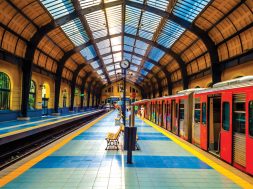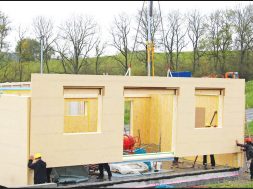A question rooted in time

Opulence and luxury have become keywords in architecture and design but an introspection is needed about the perceptional intent of these terms. Perhaps it also has to do with the needs and wants of the timeline we are living in.
The idea of opulence and timelessness in architecture is subjective and to quite an extent it depends on the culture and lifestyle too. Minimalism may have become famous now but back in India, traditionally, simplicity has always been a way of life. If one takes a closer look at the Indian dwellings, keeping apart the imperial palaces made by kings and royals it is not difficult to understand that the statement above is indeed true. Supporting this argument Pankaj Gandhi, Director, VH Designs Studio, Ahmedabad says “In contemporary times the influence of western materials as also the architecture has been paramount. So there is a need to revisit the Indian way of life and understand the nature of simplicity which our culture imbibes. This in turn will also allow us to understand where we stand when it comes to opulence and timelessness. What is considered opulent and timeless by someone residing in Paris may not add up to what can or cannot be opulent and timeless in the Indian context.
Shashirekha, Chief Architect, Space Studio, Chennai elaborates “India as a country has been established, much ahead of many of the other nations. We were certainly ahead of others in terms of innovation as well in architecture and design. Otherwise, how can one explain the existence of ancient structures. Like for example the Tanjore Temple which is 1,000 years old and is still standing, even the modern-day structural engineers of today have still not figured out how the structural system has been done. Add to this the extensive carvings which exists, the carvings are what describes the opulent nature of the design. So in a way it is a symbiosis of innovative engineering, architecture and design.
Needless to say a lot of work goes in to create such structures. As a country, we’ve lost this touch of magic in terms of architecture, a magic which ensured we stay ahead of the rest of the world, a magic which resulted in creation of marvels which we adore till date, 1,000 years later. As we try to address these exceptional queries smaller sub regions in Northern Europe like Scandinavia are coming up with intelligent projects. As we become increasingly globalised, architecture and interior design turn into a tool to showcase the financial prowess of an individual. This is especially true for certain metro cities in India. The challenge however lies in creating something that is timeless and yet not expensive.
While the argument for timelessness will continue, as infrastructure needs in cities keep augmenting, the architect and design community tends to fall back on new age materials to suffice the needs of the rising population. Ajay Kapur, CEO Aluminium & Power Business & MD – Commercial, Vedanta Ltd points out “ As the global population increases, the need for taller, more energy-efficient and environmentally compatible buildings will rise. The dynamically shifting consciousness of the world is making it look for effectual solutions for smart building trends suitable for the 21st century, like automation and control of the façade elements thereby providing optimal light conditions, air flow, solar shading, and energy storage and distribution. Aluminium is the perfect material for such systems, applicable for large-surface use and extreme loading.”
“Aluminium,” in Ajay’s view “is a metal of infinite creativity at the hands of an architect. It allows him or her to create structures or designs that are not possible with wood, plastic, or steel. Although India has established a significant footprint in exploring myriad aluminium applications used in buildings and construction, there is a long way to go in attaining design mastery using the properties of this metal. With increasing focus on building & construction sector, there are vast opportunities for aluminium applications and development of new alloys and other customizations to make the structures as light and as sturdy as possible.”
He adds “Today, aluminium ingots, billets and rolled products find the most usage in creating architectural structures. These are then extruded into structural components which are further fabricated for usage in a diverse range of applications like floating ceilings, windows, doors, stairs, wall panels, roof sheets, curtain walls and many more. Aluminium flat rolled products, hot- and cold-finished, are used for production of aluminium sheets which are widely used in construction of warehouses, roofing, etc. Magnesium-silicon 6xxx alloys in billet form are the most conducive for extrusion purposes, offering a vast scope for manufacturing the most intricate architectural shapes.”
Many a times the innovations that we embrace are not because we want to but because we have to keep in tune with the contemporary times and the same is true in architecture as also design. Abhishek Chadha, CEO, The KariGhars, Bangalore, a firm that specialises in designing residences and villas points out “Everything is software driven nowadays, post Covid, things have changed. We are we are not in the same age what existed in 2019, people want to get projects executed quickly ensuring all the detailing is in place as also precise. At the same time people are scared of face-to-face interactions. The client wants to finish the project in 45 days with minimal interaction. To be able to do that the utilisation of technology is paramount, as a design firm we have invested in technology to deliver our projects on time.”
As we continue to decipher the roots of our traditional architecture and design and where we are heading today, we will perhaps want to believe that the diversity in approach continues to exist. In a true sense it does and it will, the diversity is at the end of the day driven by individual will. The needs and wants of a city bred will differ from how a rural mind approaches it. This alone will keep the diversity in architecture and design alive. At the same time when these individual approaches cross paths, it results in a unique approach which has a larger fan following, since it will tend to gratify our senses rooted in tradition and allow us to make use of contemporary elements wherever required.
20
Cookie Consent
We use cookies to personalize your experience. By continuing to visit this website you agree to our Terms & Conditions, Privacy Policy and Cookie Policy.









